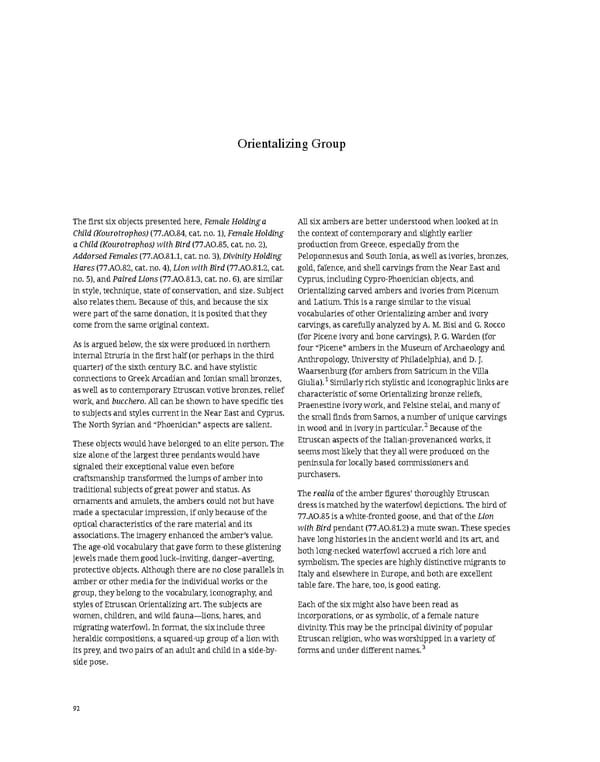Orientalizing Group The first six objects presented here, Female Holding a All six ambers are better understood when looked at in Child (Kourotrophos) (77.AO.84, cat. no. 1), Female Holding the context of contemporary and slightly earlier a Child (Kourotrophos) with Bird (77.AO.85, cat. no. 2), production from Greece, especially from the Addorsed Females(77.AO.81.1, cat. no. 3), Divinity Holding Peloponnesus and South Ionia, as well as ivories, bronzes, Hares(77.AO.82,cat. no. 4), Lion with Bird (77.AO.81.2, cat. gold, faïence, and shell carvings from the Near East and no. 5), and Paired Lions (77.AO.81.3, cat. no. 6), are similar Cyprus, including Cypro-Phoenician objects, and in style, technique, state of conservation, and size. Subject Orientalizing carved ambers and ivories from Picenum also relates them. Because of this, and because the six and Latium. This is a range similar to the visual were part of the same donation, it is posited that they vocabularies of other Orientalizing amber and ivory come from the same original context. carvings, as carefully analyzed by A. M. Bisi and G. Rocco (for Picene ivory and bone carvings), P. G. Warden (for As is argued below, the six were produced in northern four “Picene” ambers in the Museum of Archaeology and internal Etruria in the first half (or perhaps in the third Anthropology, University of Philadelphia), and D. J. quarter) of the sixth century B.C. and have stylistic Waarsenburg (for ambers from Satricum in the Villa connections to Greek Arcadian and Ionian small bronzes, Giulia).1 Similarly rich stylistic and iconographic links are as well as to contemporary Etruscan votive bronzes, relief characteristic of some Orientalizing bronze reliefs, work, andbucchero. All can be shown to have specific ties Praenestine ivory work, and Felsine stelai, and many of to subjects and styles current in the Near East and Cyprus. the small finds from Samos, a number of unique carvings The North Syrian and “Phoenician” aspects are salient. in wood and in ivory in particular.2 Because of the These objects would have belonged to an elite person. The Etruscan aspects of the Italian-provenanced works, it size alone of the largest three pendants would have seems most likely that they all were produced on the signaled their exceptional value even before peninsula for locally based commissioners and craftsmanship transformed the lumps of amber into purchasers. traditional subjects of great power and status. As Therealiaof the amber figures’ thoroughly Etruscan ornaments and amulets, the ambers could not but have dress is matched by the waterfowl depictions. The bird of made a spectacular impression, if only because of the 77.AO.85is a white-fronted goose, and that of the Lion optical characteristics of the rare material and its with Bird pendant (77.AO.81.2) a mute swan. These species associations. The imagery enhanced the amber’s value. have long histories in the ancient world and its art, and The age-old vocabulary that gave form to these glistening both long-necked waterfowl accrued a rich lore and jewels made them good luck–inviting, danger–averting, symbolism. The species are highly distinctive migrants to protective objects. Although there are no close parallels in Italy and elsewhere in Europe, and both are excellent amber or other media for the individual works or the table fare. The hare, too, is good eating. group, they belong to the vocabulary, iconography, and styles of Etruscan Orientalizing art. The subjects are Each of the six might also have been read as women, children, and wild fauna—lions, hares, and incorporations, or as symbolic, of a female nature migrating waterfowl. In format, the six include three divinity. This may be the principal divinity of popular heraldic compositions, a squared-up group of a lion with Etruscan religion, who was worshipped in a variety of its prey, and two pairs of an adult and child in a side-by- forms and under different names.3 side pose. 92
 Ancient Carved Ambers in the J. Paul Getty Museum Page 101 Page 103
Ancient Carved Ambers in the J. Paul Getty Museum Page 101 Page 103